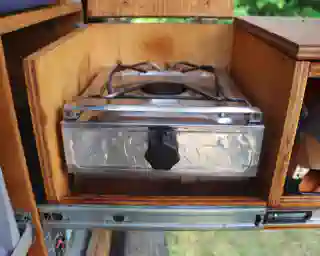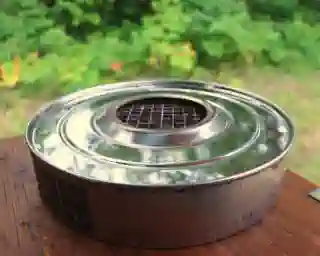
Wie kochen wir im Van - Unser Koch-Ensable
Gibt es noch andere möglichkeiten im Van zu kochen als mit Gas? Die Antwort ist JA! Hier in diesem Artikel stellen wir euch unsere Variante des Kochers und allem was dazu gehört vor.
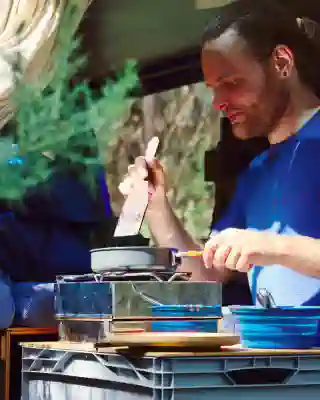
Werbung, unbeauftragt! Bei diesem Text handelt es sich um einen redaktionellen Beitrag, der unbeabsichtigt durchaus eine werbende Wirkung beim Leser haben könnte, ohne dass ich von irgendeinem Unternehmen dafür beauftragt wurde!
Kulinarische Abenteuer unterwegs
Kochen mit Gas
Am Anfang unserer Reise haben wir uns mit einem Gaskocher ausgestattet, der von einer 5,6 kg Gasflasche betrieben wird. Heutzutage gibt es unzählige Varianten und Modelle von Gaskochern. Doch was wir schnell gemerkt haben: Der Umgang mit Gas auf Reisen ist deutlich komplexer als gedacht.
Gasflaschen sind nicht standardisiert, das bedeutet, dass jedes Land seine eigenen Gasflaschentypen und Anschlüsse hat.
Unsere erste Station war Schweden, und wir sind dankbar, dass uns dort das Gas nicht ausgegangen ist. Andernfalls hätten wir eine weitere Gasflasche kaufen müssen. Die deutsche Gasflasche hätte in Schweden nicht akzeptiert oder getauscht werden können. Wir hätten eine neue kaufen und die deutsche Flasche mitschleppen müssen.
Das ist kein Problem, wenn man viel Platz hat. Doch wenn jeder Zentimeter zählt, wie bei uns, nimmt eine zweite Gasflasche zu viel Raum ein.
Eine alternative Option (mit der wir auch vertraut sind) ist die Verwendung von Campingaz-Flaschen. Diese können in vielen europäischen Ländern gekauft werden. Allerdings sind sie relativ teuer.
Camper-Regelungen
Besonders wenn dein Van als Wohnmobil zugelassen werden soll, wird die Verwendung einer großen Gasflasche komplizierter.
Laut den Vorschriften muss die Gasflasche in einem Gasfach mit Belüftungsöffnungen nach außen platziert und mit einem starren Gasrohr verbunden werden. Dieses gesamte Setup muss einer Inspektion standhalten.
Übrigens, nach der Überarbeitung der Vorschriften im Jahr 2022 müssen zusätzliche Überlegungen berücksichtigt werden. Am besten recherchiert man online oder erkundigt sich direkt bei den zuständigen Behörden.
Der Kompakt-Gaskocher
Die bekanntesten Kocher sind diejenigen, die kleine Gaskartuschen verwenden. Wir haben immer einen solchen Kocher für Festivals dabei gehabt. Wir behalten immer noch einen als Reserve, und er ist auch bei unseren Wander- und Kanutouren nützlich. (Schau gerne unseren Beitrag X für weitere Informationen dazu an.)
Doch für diejenigen, die ausgiebig mit einem Van unterwegs sind und durch verschiedene Länder gereist sind, zeigt sich schnell ein Muster.
Der Kocher ist ständig im Einsatz, besonders im Winter. Kaffee und Tee zubereiten, den Omnia Ofen nutzen, Wasser für Pasta kochen oder Reis und süß-saure Soße vorbereiten – diese Aktivitäten können das Gas schnell aufbrauchen.
Das Entsorgungsproblem
Die Entsorgung von Gaskartuschen ist eine Herausforderung, und leider werfen die meisten Menschen sie einfach in den Müll.
In vielen Ländern ist Abfall ein ernsthaftes Problem. Jeder, der durch Italien, Griechenland oder Albanien gereist ist, hat das Ausmaß des Problems gesehen. (Auch wenn die Einheimischen sich des Problems nicht immer vollständig bewusst sind oder andere Anliegen haben.)
Für uns, die wir die Komplexität der Abfallentsorgung verstehen, war eine alternative Lösung notwendig.
Zudem spielt der Preis kleinerer Gaskartuschen eine Rolle. Bei kontinuierlicher Verwendung können diese Kartuschen teuer werden.
Die Holz-Option
Eine Alternative ist die Verwendung von Holz und das Kochen über offener Flamme. Holz ist fast überall verfügbar, und in vielen Ländern stellt das Anzünden eines Feuers kein Problem dar. Allerdings gibt es zwei Wetterbedingungen, bei denen es sich nicht empfiehlt, sich ausschließlich auf offenes Feuer zu verlassen.
Bei Stürmen und Regen bevorzugt man das Kochen drinnen. Zudem besteht in vielen Regionen die Gefahr von Waldbränden bei heißem Wetter.
Daher ist es wichtig, in solchen Situationen vorsichtig zu sein.
Waldbrandgefahr
Drei Monate nach unserem Besuch in Bordeaux und der Dune du Pilat brach dort ein schwerer Waldbrand aus. Der Wald, den wir besucht hatten, war komplett zerstört. Ähnliche Situationen können in Regionen wie Brandenburg, Sibirien oder Kanada auftreten. Diese Brände können verheerende Folgen haben.Unser Kochensemble
Nach einigen Jahren auf der Straße können wir behaupten, für unseren kleinen Van das Optimum gefunden zu haben.
Unsere Lösung: Spirituskocher
Nach reiflicher Überlegung haben wir uns für einen Spirituskocher entschieden.
Dieser Kocher ist zwar eher auf Booten bekannt, aber was auf einem Schiff funktioniert, geht auch im Van! Der Kocher wird mit einer Kartusche betrieben, die mit Brennspiritus befüllt wird.
Wir wissen, dass es auf dem Markt nicht besonders viele Spirituskocher gibt. Leider ist der Spirituskocher Origo von Dometic selten verfügbar. Vielleicht habt ihr Glück und könnt ihn auf eBay finden. Das ist jedoch reine Glückssache. Die Alternative, die wir gekauft haben ist von compass Der von Compass sieht sogar ähnlich aus und ist sehr einfach in der Handhabung.
Ist das nicht gefährlich?
Nein, nicht gefährlicher als das Kochen mit Gas. Beim Kochen über offene Flammen muss man natürlich immer vorsichtig sein.
Ist der Kocher genauso effizient wie ein Gaskocher?
Unser Kocher hat eine Leistung von 2kW. Das ist etwas weniger als bei einem Gaskocher, aber wir kommen prima zurecht. Einzig starker Wind kann ein Problem sein!
Es ist also ratsam, den Kocher vor Seitenwinden zu schützen.
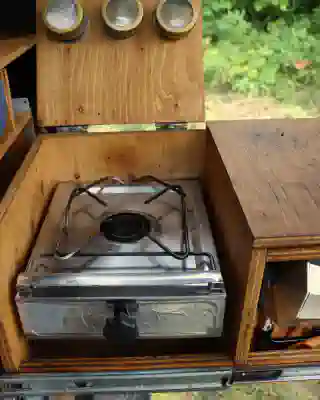
Wir haben den Kocher in unserer Kochbox von den Seiten her gegen den Wind geschützt, was sehr gut funktioniert. Und wenn der Wind mal sehr stark ist, kann man ihn einfach herausnehmen. Das Gute an diesem Kocher ist nämlich, dass er leicht zu transportieren ist.
So können wir ihn auch problemlos ins Innere mitnehmen, wenn das Wetter draußen ungemütlich ist.
Die Töpfe: Wärmetauscher sind ein muss!
Zusätzlich verwenden wir Töpfe mit Wärmetauschern. (Übrigens sind diese auch bei der Verwendung von Gas sehr sinnvoll, da das Wasser hierdurch schneller kocht!)
Das Prinzip ist einfach: Durch einen Ring aus Lamellen unter dem Topfboden wird die Wärme besser verteilt und weniger Energie benötigt. Es gibt verschiedene Hersteller von Kochgeschirr mit Wärmetauscher, und wir können nur empfehlen, solch einen Topf zu verwenden.
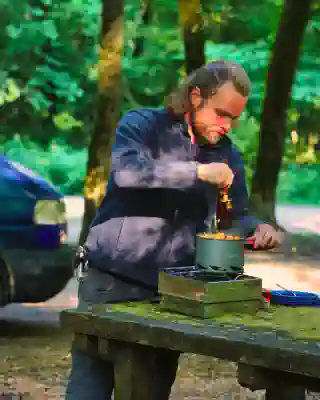
Dank dieser Konfiguration kochen wir äußerst effizient.
Treibstoff: Brennspiritus und wo er zu finden ist
Natürlich benötigt ein Kocher Brennstoff. In Deutschland bekommt man diesen in jedem Baumarkt. Doch wie ist es in anderen Ländern? Gibt es dort auch überall Brennspiritus?
Die Antwort ist: Ja und nein! In Europa haben wir bereits viele Länder bereist, und wir mussten weder auf unseren Kaffee verzichten noch Angst haben, keinen Brennstoff zu finden.
Der Brennstoff für unseren Spirituskocher ist Alkohol, und den gibt es überall. Es kann jedoch manchmal etwas knifflig sein, ihn möglichst preiswert zu finden, besonders wenn man die Landessprache nicht spricht.
Wenn es wirklich schwierig geworden wäre, hätten wir immer in eine Apotheke fahren können, um Ethanol zu kaufen.
Übrigens eignet sich Alkohol mit einem Gehalt von über 70 % am besten. Sekt oder Wein lohnen sich nicht, und auch Alkoholreiniger brennen nicht wirklich gut.
Weitere Infos zum Thema Brennspiritus findest du in unserem Artikel: XXX
